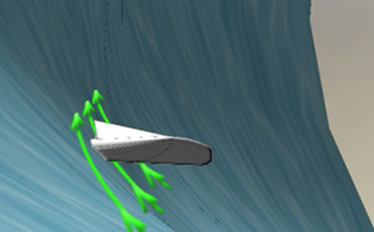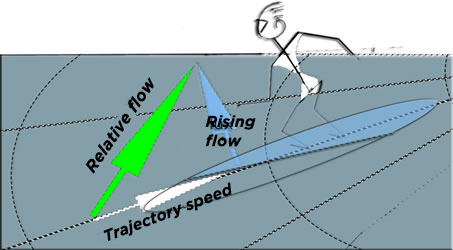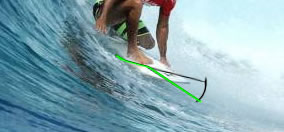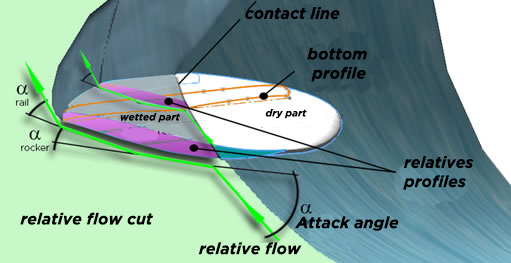Hydrodynamic lift and drag calculations always use relative flux. The relative flow gives the direction and the speed perceived by an object immersed in a current of fluid. Whether the object is in motion like a boat advancing on a lake, or whether the fluid is in motion like a current around a fixed buoy, makes no difference. The hydrodynamicist considers the fluid moving relative to the object, the board or the surfer.

Relative flow
The relative flow actually perceived by our board results mainly from 2 components: the speed of the surfer on his trajectory, and the speed of the flow rising vertically..

Relative flow velocity components
PLANING ANGLE OF ATTACK:

If we compare the direction of the relative flow with the bottom of the board, in a vertical plane, parallel to the displacement of the relative flow, we obtain the planing angle of attack. This angle is a major contributor to planing lift forces..![]() The angle of attack of planing varies according to the phases of the wave between 5° in the acceleration phases where the surfer is leaning on the front, up to 45° during intense braking in leaning on the back. In a stable phase at Still-point we will estimate it around 10 degrees. The experiments of (LORD, 1946), the work of (Savitsky, 1964), and the method by plank elements, exposed later in this work, we will give more precise information on the values of planing angles..
The angle of attack of planing varies according to the phases of the wave between 5° in the acceleration phases where the surfer is leaning on the front, up to 45° during intense braking in leaning on the back. In a stable phase at Still-point we will estimate it around 10 degrees. The experiments of (LORD, 1946), the work of (Savitsky, 1964), and the method by plank elements, exposed later in this work, we will give more precise information on the values of planing angles..

This definition of the angle of attack is specified "in planing" because it only applies to the study of partially submerged profiles of which only one side, here the bottom of the board, is in contact with the water.
the hydrodynamic angle of attack of fully submerged profiles is defined slightly differently: 
When an active part of the board is completely submerged, the fin being an example, the fluid bypasses its profile by generating forces relative to the total shape of the profile. The angle of incidence (alpha) of the profile is then defined by the direction of the relative flow(v∞) and the chord line(c) connecting the attack zone (A) and the trailing area(B) of the profile: